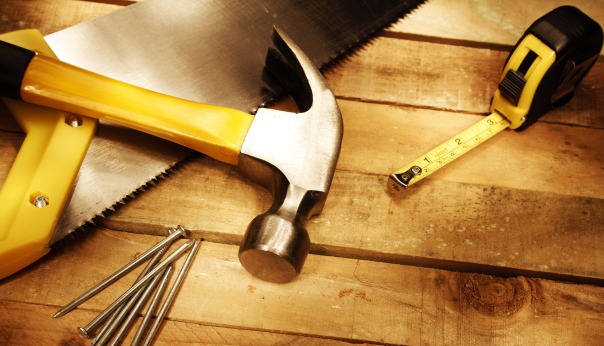We’re talking hand tools, here. This is Primer, not an Eli Roth movie. The tools are listed in order from most obvious to coolest, so as you read you should feel adrenaline mounting, blood surging to your head. Without further ado, in Exciting Countdown Style, here they are: the Ten Tools.

10. Tape Measure
While not an overtly macho tool, the tape measure is the device behind the “measure twice, cut once” adage. This can also be rephrased “measure twice, buy once”, or “two measurements, one trip to the paint store.” Unless you are sewing, or doing an arts & crafts project, using a yardstick is totally lame. So get a 25′ tape and start measuring.
Painting walls? Height times Width equals Area. (This will tell you how much paint to buy.) Want to know if that new ski rack will clear the roof of your garage, or if that new futon couch will fit next to the kitchen table? The answer is in the tape.
9. Screwdriver
This one is pretty obvious. Screwdrivers are as much a part of our daily lives as espresso and NASCAR racing. What’s not so obvious is that you need a few different sizes. Using the wrong size screwdriver causes slipping. Slipping ruins both the screw and the head of the screwdriver, and the ensuing frustration is guaranteed to show people your ugly side.
While there are many head types, the only ones you need are slotted / flat head and Phillips. Get two sizes for each head type. I think the sizes are designated #0 (tiny) thru #4 (pretty darn big). You want #2 and #3, but just ask for the two most common sizes.
Note: If you are the youngest child in a large family, buying a huge, slotted screwdriver may help suppress your feelings of inadequacy.
Extra Credit: If you own glasses, musical instruments, or like to play with gadgets, such as hard drives, then get a set of jewelry screwdrivers. These are about 3″ long, with a convenient swivel on the handle’s end. Keep them in the box, or you will lose them.
8. Hammer
Again, this one is so obvious it barely needs explanation. Hammers have many uses, even for the non-handyman. Feeling artsy? Pound a nail into the wall and hang up a picture. Feeling angry? There’s no vent like busting a hole in your apartment’s drywall. (In a later issue, we’ll show you how to get your whole damage deposit back with minimum effort.) You can even use them on some cars to tighten the alternator belt.
7. Crescent (Adjustable) Wrench
If you only own one wrench, this is it. It has a little adjuster that you move with your thumb. Don’t bother trying to remember which way tightens and which way loosens the wrench. You will always turn it the wrong way first, chuckle at your own forgetfulness, then turn it the right way. A 1″ crescent wrench should take care of most jobs. A bigger wrench may also be handy for larger nuts/bolts.
To use, simply tighten the wrench down onto your nut or bolt. Make it as tight as possible, to avoid slipping, which wears out, or “dog ears,” the nut. While not as important a rule to remember as on the pipe wrench (see below), the solid, non-moving end should be behind the direction you’re turning. Let’s call this the Back Away rule.
Note: After use, always tighten your wrench until it is completely closed; this shows any woman who might examine your toolbox that you are thorough and caring.
6. Box/Open-end Wrench Set
Box-end and open-end wrenches are the bread-and-butter of the wrench family. Simple, yet effective, they are a class above the crescent wrench. Each wrench has a fixed size, so you won’t damage your nuts (ouch), and they are small enough to fit into tight spaces.
The most useful variation, known as a combination wrench, has a box on one end (i.e. a closed ring), and is open on the other. A typical set usually ranges from somewhere around 7/16″ to 3/4″ SAE or, in Metric sizes 7mm to 16mm. A Metric set will probably give you the most bang for your buck, but if you’re feeling frisky, get both.
Note: Even many American cars have parts made elsewhere, using Metric-sized nuts and bolts. For best results, try to figure out which system is being used, and use the right set of wrenches for the job.
5. Pliers (Channel Lock, Vice Grips, Needle-Nose)
The plier family is full of cousins and step-brothers. Unlike actual cousins and step-brothers, however, all members of the plier family serve distinct and useful purposes. The most important ones are vice grips (AKA locking pliers) and needle-nose pliers.
Needle-nose pliers are useful for precise jobs, and include a handy wire cutter. Though these two will serve you well, you should eventually get basic adjustable-joint pliers, and a Channel lock (big adjustable-joint pliers).
Extra Credit: If you do any electronic or electrical work, you’ll also want a wire stripper. This is different than a wire cutter because, as the name suggests, it strips the coating from the wire, while leaving the wire intact.
Have a tool you couldn’t “fix” without? Let us know in the comments. We are also ITI tools supplier In Delhi